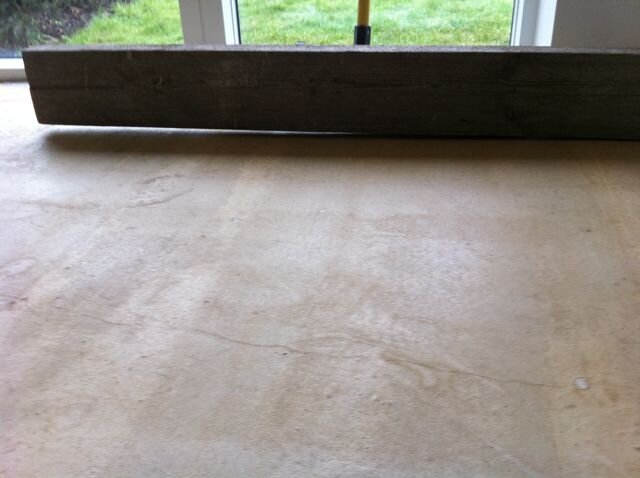D
You are using an out of date browser. It may not display this or other websites correctly.
You should upgrade or use an alternative browser.
You should upgrade or use an alternative browser.
Self levelling screed???
B
Brinkley
:yikes:looks like the rockys captain
I
Ian
Few bags of SLC then!!!
J
jay
dont you just hate it when you have large format tiles to lay not the best captain:yikes:
Oh my giddy aunt. That is awful. Is that dips between the pipes (I assume its UFH). This is called pipe mapping and it is caused by one of 3 things.
1. Pipes not fully secured ad have floated - this usually is patchy and sporadic and does not appear to be the case here
2. The screed is placed too thin with a lack of cover to the underfloor heating pipes. This leads to a differential between the level of plastic settlement, a natural function of a flowing screed (self levelling compound does the same thing), between the pipes being greater than that over the pipes. It is often accompanied by cracking across the tops of the pipes
3. The screed has been placed too wet which leads to a similar phenomenon as described in number 2.This scenario is also often accompanied by level issues as the excessive water content in the screed bleeds to the surface and makes it difficult for the installer to differentiate the actual top of the screed and the bleed water on the top. It is also often accompanied by soft powdery patches often in door ways where the bleed water gets chased and causes the screed to segregate locally.
If it is installed correctly then it does exhibit self levelling tendencies. In terms of deviation from the straight edge I would expect in a job of this size that there would be little to none but the screeders generally should install to SR2 as an absolute minimum standard.
You will presumably use a smoothing compound over this one - I would suggest one based on Gypsum. Also are you uncoupling cos that level of "defficiency" could also lead to the screed cracking under thermal loading.........
1. Pipes not fully secured ad have floated - this usually is patchy and sporadic and does not appear to be the case here
2. The screed is placed too thin with a lack of cover to the underfloor heating pipes. This leads to a differential between the level of plastic settlement, a natural function of a flowing screed (self levelling compound does the same thing), between the pipes being greater than that over the pipes. It is often accompanied by cracking across the tops of the pipes
3. The screed has been placed too wet which leads to a similar phenomenon as described in number 2.This scenario is also often accompanied by level issues as the excessive water content in the screed bleeds to the surface and makes it difficult for the installer to differentiate the actual top of the screed and the bleed water on the top. It is also often accompanied by soft powdery patches often in door ways where the bleed water gets chased and causes the screed to segregate locally.
If it is installed correctly then it does exhibit self levelling tendencies. In terms of deviation from the straight edge I would expect in a job of this size that there would be little to none but the screeders generally should install to SR2 as an absolute minimum standard.
You will presumably use a smoothing compound over this one - I would suggest one based on Gypsum. Also are you uncoupling cos that level of "defficiency" could also lead to the screed cracking under thermal loading.........
D
Daz
You are absolutely correct, there was a substantial amount of making good. However, my query is with regards to Anyhdrite / Gyvlon screeds. I thought they are supposed to be self levelling?
Was typing at the same time as Alan, so these comments do not apply until I have read the post from Ajax :lol:
Was typing at the same time as Alan, so these comments do not apply until I have read the post from Ajax :lol:
Last edited by a moderator:
B
Brinkley
are you able to put a slc over a gyvlon screed ajax and if so does it need longer to dry
are you able to put a slc over a gyvlon screed ajax and if so does it need longer to dry
Yes you can put SLC over Gyvlon. I would always recommend one based on Gypsum so that it is fully compatible with the screed and eliminates the risk of chemical delamination. All the same rules apply in that the heating must be commissioned, the screed must be dry, surface must be clean and sound etc.....
D
Daz
Alan, this is the very same screed that you viewed with me in November. It looked alright then didn't it :lol:. I have lightly sanded the screed (I will provide a full anhydrite thread for forum members soon) and found no cracks whatsoever. The screed is even in colour which, to me, indicates an even moisture content too. I can't see any obvious reasons for the screed to be so poor which is why I asked the question. I'm really disappointed with the installers.
There are similar tiling threads here
- Replies
- 5
- Views
- 2K
Advertisement
- Tilers Online Chatroom (no need to register)
- Tile Bulletin Board
- Tilers Talk UK | Tilers Blog
- Community for Tilers
- UK Tile Forums
- USA Tile Board
- Ireland Tiling Advice
- Australa Tile Advice
- Canada Tiling Advice
- Tilers Talk Forum
- Plumbers Talk - PlumbersTalk.co.uk
- Electricians Talk - ElectriciansTalk.co.uk

